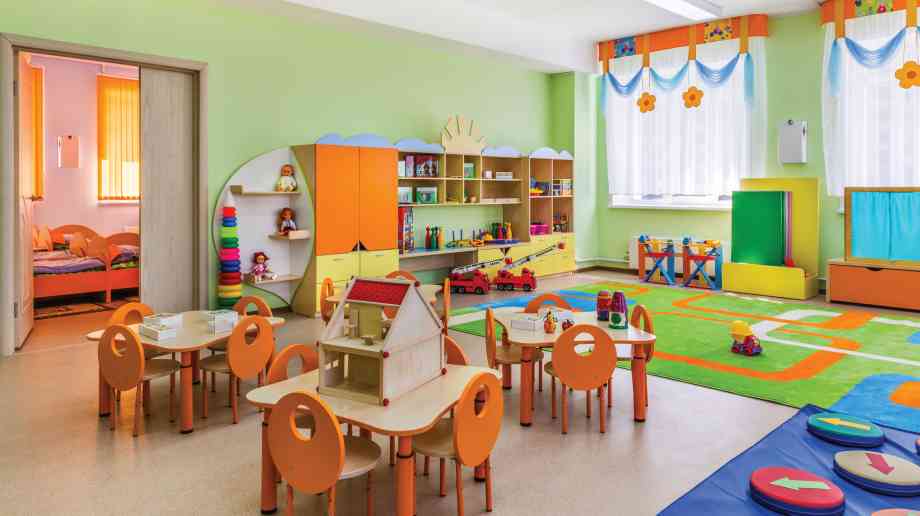
The importance of considering safety
When it comes to indoor furniture and outdoor play equipment, the same health and safety considerations apply, advises Caroline Wright, BESA’s director general designate.
In the 21st century technology-led learning environment, we generally consider a school’s duty of care to be based on ICT and Internet safety. However, protecting the physical safety of our children is a more traditional consideration that should not be forgotten.
Having children sitting on well-designed furniture with a good posture, on chairs appropriately designed for their size is an important aspect of a school’s ‘duty of care’. While this can be easily overlooked, children sitting comfortably are also more likely to be attentive and focused on learning.
In addition to this, use of play equipment is an important part of children’s early years’ development and should also be high on the list of safety considerations. It is interesting to note that, broadly speaking, the same safety considerations apply to both classroom furniture and outdoor play equipment. So we pulled in advice from BESA member organisations, Gratnells and Educational Play, to give their guidance on buying furniture and play equipment that will both help support learning and safeguard children’s health.
Standards
Over recent years, BESA’s furniture group has successfully campaigned for the introduction of a new British Standard for classroom furniture, BS EN 1729, which ensures that tables, desks and chairs made for school use are properly shaped, sized and developed. This supports the prevention of long-term damage to children’s backs and also helps them concentrate on learning without suffering discomfort. The same applies to playground equipment.
Richard Frost, CEO at Educational Play, advises: “Schools should look to see if equipment adheres to the Royal Society for the Prevention of Accidents (RoSPA) standard EN 1176. The European Standards for Playground Equipment: EN 1176 and EN 1177 have been published to harmonise existing criteria and cover issues such as critical fall heights of outdoor play equipment.”
Research has shown that high quality, well‑designed furniture improves concentration and reduces misbehaviour, leading to better learning outcomes, so it is worth taking the time to make the right decision for your pupils. Schools should be aware that the British Standard for school furniture (BS EN 1729), is advisory and not mandatory. To ensure that your pupils receive the best possible opportunity to learn in a safe and comfortable environment, you should always double check that your supplier conforms to these standards.
Richard Picking, marketing director of Gratnells, offers some thoughts about the future for school furniture.
He says: “The healthy learning environment is a composite of elements. Apart from the obvious bricks and mortar requirements, teachers need bright, light and secure classrooms where colour abounds and learning resources are plentiful. More than ever, the creation of a child‑centred environment relies on a mix of form and function – a balance between free creativity and good order. This is where good furniture design comes into its own to help the teaching process.”
Fostering health & safety
Many of the UK’s leading school furniture suppliers are members of BESA, which is committed to improving the quality and safety of these investments. Buying furniture from BESA member organisations gives you the peace of mind that you are buying high quality furniture appropriate to your specific needs, along with an excellent level of customer care. Gratnells is one such BESA member.
Richard Picking explains: “Flexibility, adaptability and mobility are the key attributes in helping to create the range of different work spaces needed to foster children’s creativity while ensuring an efficient system of storage and resources.
“Affordable modular systems do exist now to create a range of layouts, adapting to the needs and size of the learner group, as well as the subjects being taught. Designing a literacy corner, organising art groups or facilitating a science demonstration require very different arrangements.
“At primary and junior level, the accent is likely to be on the teacher’s ability to see the faces of every pupil and for the children to interact with each other as much as possible.”
BESA member Educational Play will visit a site first to advise on the best use of a particular space and identify any potential safety issues that may arise. If your supplier isn’t offering this important service, you may want to look at alternative options, as this suggests that safety is not a leading consideration for them.
Value for money
Some of the budget furniture available on the high street might seem like good value for money at the outset, as well as a cheaper option than some purpose‑made alternatives. However in a school environment, furniture needs to be highly durable to stand up to classroom demands. In the current economic climate, whole life-cycle costs are very important.
Look at the supplier’s case studies and if it is a large investment, contact the schools already using the equipment to find out what they think of the furniture.
As Richard Frost adds: “At Educational Play we recommend that schools chose equipment that looks well-made and sturdy.”
Whether classroom furniture or play equipment, if the product hasn’t been manufactured to cope with stress and high-impact use, its lifespan may be shorter and therefore prove more costly in the long-run. A warranty is a good indicator of durability; many BESA members offer a ten-year guarantee, and company history is also an important quality by which you can evaluate a supplier.
It will be crucial for you to identify where and how the furniture will be used before making a purchasing decision. If your school is looking for furniture that can be used both indoors and outdoors, ensure that your supplier is a specialist in this particular area. Materials such as moisture resistant MDF, architectural grade powder coat paint work, and UV stable plastics are necessary for outdoor use.
s Richard Picking explains: “As learners become more mature and their social interaction becomes much more spontaneous, there is more of a premium on the furniture and systems supporting integral elements of the teaching mix, such as science, technology and advanced practical study. In arts, too, the need for a disciplined system of storage and archiving is required, to keep creative materials and works in progress in pristine condition.”
Ergonomics
The wrong choice of chair or size of play equipment could result in back pain. Remember that the height of a chair should relate to the height of a table.
Quality manufacturers following British Standard guidelines will have calculated the ideal distance between the seat of the chair and the table to ensure maximum comfort and ergonomic benefits for the pupil.
Research dating back to the 1990s suggests the size measurement on which most children’s furniture was based on the average size of children in the 1960s, when they tended to be shorter. The British Standard guidelines recommend that schools purchase furniture with the appropriate dimensions for the age and size of the children using the equipment.
As Richard Frost explains: “It is also important to ensure you check whether the product has a long warranty/guarantee. If it does, it suggests that the equipment is well made and that the company wants a long term, supportive relationship with the school.
“The supplier should also provide instructions for aftercare or a maintenance package so that the equipment continues to be safe. For example, will you need to sand edges or repaint and how often?”
Richard Picking summarises that: “Providers are finding new ways to work in education. They are adapting and adopting new technologies without abandoning time honoured requirements such as comfort and safety in pursuit of the optimum balance between a stimulating creative environment and an efficient, flexible learning infrastructure.”
Finally, all play equipment providers should have a ROSPA certified inspector to provide you with advice on the safety of the equipment. There is also no reason why even at a very young age, you can’t talk the children through the basics of safe play.
Further Information
www.besa.org.uk
Latest News
21/11/2025 - 09:37
The framework provides a practical guide to integrating education and health for better outcomes for children and young people.
20/11/2025 - 10:42
Parents will be able to get Enhanced Disclosure and Barring Service (DBS) checks when hiring private tutors, carers and therapists, among others.
20/11/2025 - 10:37
The government is funding research into developing smarter data tools to help identify children with special educational needs sooner.
20/11/2025 - 09:48
The programme prioritises schools with the highest proportion of pupils on free school meals to ensure the benefits are felt where it is most needed.
19/11/2025 - 09:41
Skills England has announced that development of the second round of Local Skills Improvement Plans (LSIPs) is now underway and has published guidance to steer the process







